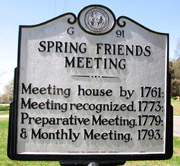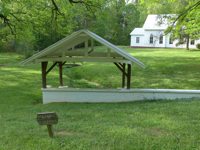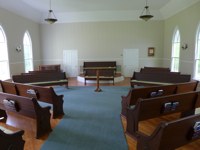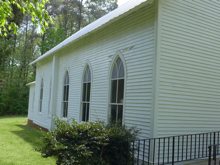 One
of
the
groups
that
emerged
from
the
turmoil
of
the
English Reformation in the mid-seventeenth century
was the Religious Society of Friends (Quakers).
Friends did not believe that Christians must rely on
a paid priestly class for guidance. Rather, they
sought guidance from their own inner light, from the
"Christ within," that could lead them toward God's
will.
One
of
the
groups
that
emerged
from
the
turmoil
of
the
English Reformation in the mid-seventeenth century
was the Religious Society of Friends (Quakers).
Friends did not believe that Christians must rely on
a paid priestly class for guidance. Rather, they
sought guidance from their own inner light, from the
"Christ within," that could lead them toward God's
will. In the famous words of early Friend George Fox at Ulverston, England, in 1652:
You will say Christ
saith this, and the apostles say this, but what
canst thou say? Art thou a child of Light and
hast thou walked in the Light, and what thou
spaekest is it inwardly from God?
Early Meetings - The distinctive unprogrammed meeting for worship evolved as an expression of Quaker reliance on the Christ within. During meeting, worshippers waited on the Lord in silence, unless one or more worshippers felt moved to speak -- in Quaker terms, felt a "leading" to speak.
The Testimonies - Gradually, through prayerful discussion and through deliberate set proceedings, Friends came to adopt some leadings as shared, communal convictions. A leading that progressed in this way became a published "testimony." Friends testimonies against slavery, for equality, and against violence greatly influenced the abolitionist, women's rights, and peace movements in the United States and elsewhere.
New World - William Penn, a prominent English Friend, founded a colony in the New World only twenty-nine years after Fox had challenged the Ulverston gathering with "What canst thou say?" Friends could settle in Pennsylvania without fear of the persecution they often suffered in England and in other parts of the American colonies.
Central North Carolina - In the mid-eighteenth century, certain Friends from Pennsylvania emigrated to Cane Creek Valley in central North Carolina, where Spring meeting was among the first of many Quaker meetings established in the area.
Friends first started meeting “at the spring” around 1761, previously meeting as part of Cane Creek Friends Meeting, which was established as a monthly meeting in 1751. The earliest written record of the Meeting can be found in the words of Daniel Stanton, a visiting Friend from Pennsylvania, who on Second Month (February) 6, 1761 wrote:
“We
…had a meeting at…the Spring, which though small… (was
a good meeting)…and Friends were glad to see us.”

Spring was named for the free flowing springs located around the site. (On any given meeting day, you can probably find some of our children still playing in one of the springs!) Located in central North Carolina and about equidistant from the towns of Burlington, Chapel Hill, Pittsboro and Siler City, Spring, which is a rural meeting, draws its attenders and members from this broad area. These “friends” come from diverse spiritual backgrounds to gather and worship as “Friends”.
One may find that a universal and definitive description of Friends’ worship, as well as of our basic beliefs, is difficult to come by. Over the last 175 years, Friends have unfortunately divided themselves into many different groups. Many have since grown apart in form of worship and even theology. For the first 150 years of its presence, Spring existed as a meeting in the more traditional form of Quaker worship. Such worship is characterized by Friends gathering and collectively waiting upon the Lord “out of the silence”. That silence could be occasionally punctuated by divinely inspired leadings by various members and attenders. For the next 90 years of its existence, Spring generally adopted a pastoral form of worship. More recently, Friends at Spring have endeavored to bridge the many branches of Friends’ groups, adopting a “semi-programmed” form of worship. Spring does not employ a pastoral minister, as do some meetings. Rather, Spring draws upon the active contributions and involvement of its members and attenders. A typical month at Spring would include:
- One First Day (Sunday) of the
month of “unprogrammed” worship, or worship “out of
the silence”. Traditionally this is the first
Sunday of the month, although this varies at times
to accommodate specific guest speakers.
- Two First Days (Sundays) of the month of “semi-programmed” worship, with a guest or visitor (often from Guilford College’s Quaker Leadership Scholars Program) bringing a brief message and concluding with a season of worship "out of the silence”.
- One First Day (Sunday) of the month of “semi-programmed” worship, with a brief message offered by one of our members or attenders and concluding with a season of worship “out of the silence".
- When a fifth First Day (fifth Sunday) occurs during a month, Spring usually enjoys a “hymn sing” in which members and attenders participate in choosing hymns and lifting our voices to the Lord. The hymn sing is also concluded with a season of worship “out of the silence”.
- First Day (Sunday) school is held as scheduled, except during the summer months, with classes for both children and adults. Some First Day school sessions are devoted to a meeting wide "forum" where a particular subject is presented. Past forums have included visits by some of our Muslim neighbors, Friends relating their experience as conscientious objectors during World War II, discussions on living wills & health care issues, presentations by various local charities, etc.

Spring has a long history of witness to the community. Early in our history, a battle of the American Revolution, known as the “Battle of Lindley’s Mill” was fought on and around the grounds. In this battle, several hundred troops were engaged with many finding final resting places in our burial ground. The governor of the State and his council were actually held prisoner in the log meeting house of the time.
Friends of Spring Meeting were also actively involved with efforts along the Underground Railroad, assisting others in their quest for freedom. Members of the meeting also suffered for faithfully clinging to our Peace Testimony during the Civil War.
 Spring’s
current
meeting
house is believed to be the third on the site.
Constructed in 1907, it is listed on the National
Register of Historic Places and reflects the influence
of the twentieth century pastoral movement among North
Carolina Friends.
Spring’s
current
meeting
house is believed to be the third on the site.
Constructed in 1907, it is listed on the National
Register of Historic Places and reflects the influence
of the twentieth century pastoral movement among North
Carolina Friends.History is interesting to read and nice to claim, but says little or nothing about the character of our present state. For this, we must rely upon our own actions. Friends at Spring are currently involved in a number of activities that might in some small measure be considered along side those deeds of our predecessors. Spring Meeting's members and attenders are active participants and supporters of the Snow Camp Outdoor Theatre, which produces the acclaimed, historically based dramas “Sword of Peace” and “Pathway to Freedom”, which depict some of the past activities and events in which Friends partook. Spring is active in laboring for abolition of the Death Penalty. We assist in disaster relief through the Friends Disaster Service. We support the “waging of Peace” as exemplified by Quaker House and the American Friends Service Committee. We also have a unique relationship with Guilford College’s Quaker Leadership Scholars Program.
 Our hope and mission is to
faithfully bear our responsibility and privilege of
promoting God’s Kingdom here on earth. We draw
upon the forebearers of our meeting as examples of how
to do so, with the full realization that the present and
future is our responsibility and in the Lord’s hands!
Our hope and mission is to
faithfully bear our responsibility and privilege of
promoting God’s Kingdom here on earth. We draw
upon the forebearers of our meeting as examples of how
to do so, with the full realization that the present and
future is our responsibility and in the Lord’s hands!